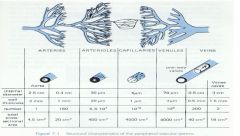![]()
![]()
![]()
Use LEFT and RIGHT arrow keys to navigate between flashcards;
Use UP and DOWN arrow keys to flip the card;
H to show hint;
A reads text to speech;
10 Cards in this Set
- Front
- Back
|
Blood Vessel Distribution
|

|
|
|
Arrangement Vascular Circuits
|
They are in parallel outside of the LV until the returning vena cava. The portion from RA to LV is in series.
|
|
|
Distribution Blood vessels (summary)
|
Distribution blood vessels (1000 fold increase X-Sectional area capillaries compared to arteries).
|
|
|
Distribution blood volume
|
Majority in venules & veins (lower resistance)
|
|
|
Distribution blood pressures
|
1. Very different in pulmonary circuit (gradient = 15-2mmHg) where systemic (gradient =100-0mmHg)
2. Resistance vessels = arterioles where BP ↓ the most (see graph) |
|
|
Equation BP, TPR, CO
|
CO = (p(a.) – p(v.) /TPR
P1 = BP at input of vessel P2 = BP at outflow of vessel R = resistance Q = Volumetric blood flow Volumetric Flow (m3/min) = (Velocity) (m/min) x (X-Sectional area) (m2) Note: volumetric flow is constant (closed system) Note: resistance = (conductance)-1 |
|
|
Most important determinant Vascular Resistance
|
Radius of vessel
Where: R= 8ɳl/(πr^4 ) l =vessel length n = fluid viscosity r = radius So although there are several factors to resistance the most dominant factor is the radius of the vessel. |
|
|
Vascular Compliance
|
C= ∆V⁄∆P.
Where C = compliance V = volume P = pressure Compliance is the equivalence of elasticity. The less compliant the less efficient the heart is. |
|
|
2 ways decrease vessel compliance causes poor cardiovascular fx
|
Compliance is fx volume change allowed per unit pressure change. It effects efficiently greatly.
1. Vessels distend to buffer the systole pulse of pressure 2. Lose recoil & ability to “store “ the systole pressure for diastole portion |
|
|
Volumetric Flow Equation
|
Volumetric Flow (m3/min) = (Velocity) (m/min) x (X-Sectional area) (m2)
Note: volumetric flow is constant (closed system) Note: resistance = (conductance)-1 |

